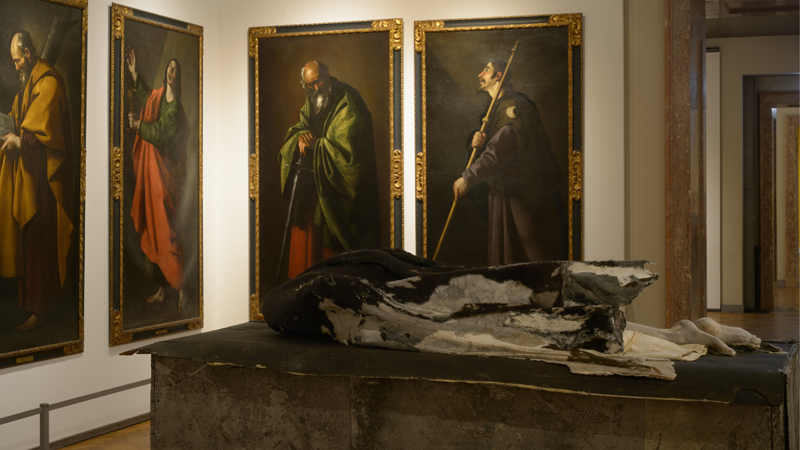Atravessar uma ponte em chamas[Crossing a bridge on fire], the title of Berlinde De Bruyckere’s temporary exhibition opening at the Museu de Arte Contemporânea/CCB, is taken from a short story by Chilean writer Roberto Bolaño. A powerful image that suggests the risk of passing from one side to another, it is also symbolic of both the appeal and the terror of the other, of transformation and metamorphosis, and of the trauma that follows any process of migration.
Berlinde De Bruyckere has been developing work in the fields of sculpture, drawing, collage, and installation around the great themes of art: death, redemption, sex, pain and memory. Inspired by the intermediary figure of the angel, this exhibition proposes a reflection on the relationship with the other, whether as transcendence, as the physicality of touch, or as personal projection. In the sequence of exhibition rooms, the artist explores these topics in works from different moments in her career, looking at their erotic power and ambiguity.
Anchored in the history of art—particularly Renaissance painting—Berlinde De Bruyckere’s work connects existing archetypes with new narratives, rediscovering themes, obsessions, and recurrences from the world of images that populate our collective memory.
To make this dialogue between historical times a reality, the Museu Nacional de Arte Antiga has kindly lent Lucas Cranach’s painting Salomé with the head of Saint John the Baptist, 1510, which is juxtaposed with the work Infinitum II, 2017–2019. Continuing this dialogue, the exhibition will also include a site in the Museu Nacional de Arte Antiga itself, where the work Liggende — Arcangelo I, 2023, will be installed in the room dedicated to Francisco de Zurbarán (1598–1664), a Spanish Baroque painter whose work is a recurring point of reference for the artist. This sculpture, representing a fallen angel (an entity that has passed from transcendence to immanence), presented in the context of a dialogue with the mysticism of Zurbarán’s painting (present in portraits that try to free themselves from earthly mundanity), once again realises the same ambiguous and back-and-forth circuit the exhibition proposes. Another important aspect of the work is its dimensions, which reproduce those of Vasco da Gama’s tomb at the Mosteiro dos Jerónimos in Lisbon.

